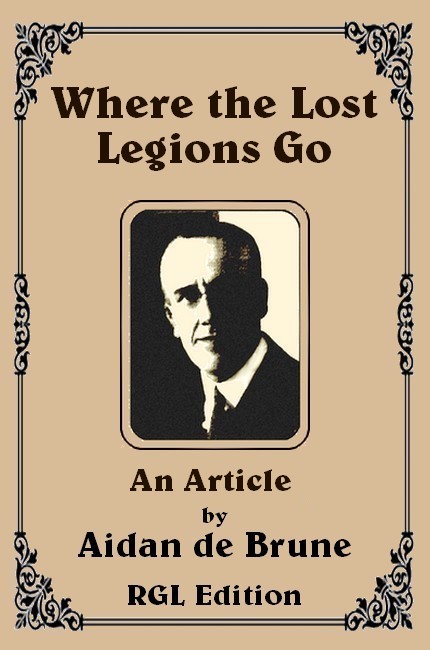
RGL e-Book Cover 2017©

RGL e-Book Cover 2017©
THIS book is a product of a collaborative effort undertaken by Project Gutenberg Australia, Roy Glashan's Library and the bibliophile Terry Walker to collect, edit and publish the works of Aidan de Brune, a colourful and prolific Australian writer whose opus is well worth saving from oblivion.
"HE left the house and..."
These words are often the prelude to one of those mysteries the police departments of the States are coming to dread.
Where has he gone to? What were the reasons behind his action? All efforts to probe his past—to discover some clue that will place the trackers on his trail—fail.
How did he do it? In these days of the greatest freedom for the individual it is remarkably easy to disappear.
"John Smith" kissed his wife and family and walked out of his home. They watched him disappear round the corner and returned to the house, prepared to welcome him at night.
But "John Smith" did not return. He did not take his usual train, or tram, into the city. Instead, he walked to some line of communications where he was unknown. Once in some strange city he went to a big store where he was an unregarded purchasing unit. There he purchased clothes varying considerably from his usual tastes. With the change of clothing he changed his identity. He became "Tom Brown."
IN new clothes, bearing a new name, he assumed a new manner.
"John Smith" may have been studious, and retiring; "Tom Brown"
sought the high spots of the night life of his new city. His
first object was to establish a new history; perhaps also a new
means of livelihood.
Amid the unobservant masses of the city he was fairly safe, even if he could not completely discard the many little mannerisms he gathered in his former life, though these are danger-points likely to betray him to a keen watcher who knew him in his "John Smith" days.
Only occasionally man or woman seeks disguise as a member of the opposite sex. The differences in outlines are so marked that betrayal is almost certain. Briefly, a man is distinguished from a woman because the many contour lines in the male are vertical, or horizontal, while the corresponding lines in the female are oblique. Thus, a man's neck back-line is straight and vertical while a woman's shows a sweeping oblique curve. A man's lower jaw is practically a right angle, while a woman's shows an open angle with oblique lines from ear to chin.
In major outline a woman's body is built in the form of two triangles, the bases resting on the hip-line. In the man the body is enclosed in one elongated triangle the base line resting on the shoulders. In movement, a woman swings her arms through a large arc, especially in a backwards direction, the hand held palm facing outwards. A man's arms swing little, except in fast walking, and the palm inclines inwards.
WHY do men and women disappear? There can be no doubt that a
majority of the disappearances are voluntary. A review of scores
of cases shows that a large proportion are persons regarded by
their acquaintances as unimaginative plodders. Can it be assumed
that the daily grind, the unadventurous, placid existence,
suddenly palled? Did a psychological reaction drive the victim
out in search of a dimly-visioned adventure? Was there some
sudden awakening of a long dormant subconsciousness inducing an
unreasoned fear that the long-worn groove was leading to mental
stagnation—at the end, the madhouse?